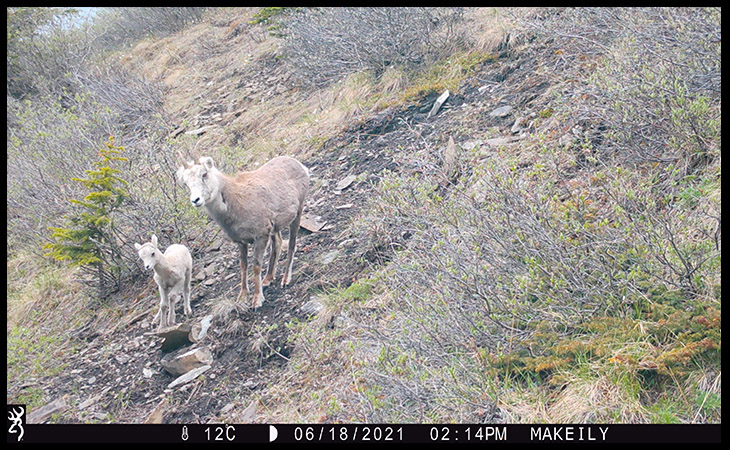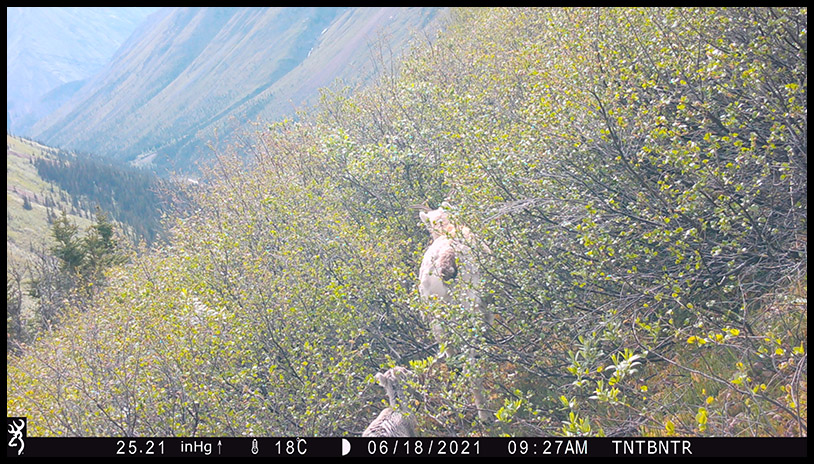“Usually within a week of a burn, as soon as that new grass pokes through, sheep are there,” said wildlife biologist Alicia Woods of Ridgeline Wildlife Enhancement Inc. “I’ve personally even seen lambs standing in the black, eating the little green shoots.”




Photos of Stone's sheep captured as part of the monitoring component of British Columbia's prescribed burn project.
These are Stone’s sheep, thinhorns found only in British Columbia and a sliver of southern Yukon. Their survival depends on open, sun-warmed slopes where they can graze and quickly spot danger. When shrubs and young trees move uphill, they block that visibility. Prescribed fire gives it back. It clears encroaching brush, restores nutrients to the soil, and sparks new growth that draws sheep within days.
“It’s habitat rejuvenation you can literally watch happen,” Woods said.
With support from the Wild Sheep Foundation (WSF) and the Wild Sheep Society of British Columbia, more than 1,200 hectares (3,000 acres) of range have been restored through carefully planned burns, each one mapped, timed, and executed with precision in Wood’s study area.
Across wild sheep country, from bighorn canyons to thinhorn peaks, fire can be both a healer and a threat. Used carelessly, it scars; used with focus, it saves. Each burn is planned using forecasts, fuel moistures, relative humidity checks, wind speed and direction, and the steady judgment of individuals who are familiar with the land and trained in fire science.

Burn event in British Columbia's Upper Prophet in May 2025.
The Science of Prescribed Burns
Ask Corey Mason, a professional wildlife biologist, what makes prescribed burns so powerful, and he doesn’t hesitate. “Fire is without a doubt one of the most impactful and constructive wildlife conservation tools we have,” said Mason, Executive Vice President of Conservation for WSF.
Early in his career, he spent years with the Texas Parks & Wildlife Department, working firsthand with prescribed burns. “It’s about harnessing a natural process and reintroducing it into systems we’ve altered by suppressing fire for decades,” he said.
For much of the past century, fire was treated as an enemy. Every spark was doused. In its absence, brush thickened, grasses declined, and layers of dead fuel built up. When ignition finally came, whether by lightning, accident, or arson, the result was a catastrophic wildfire.
“Prescribed burning reduces those fuel loads before disaster hits,” Mason explained. “It’s proactive, not reactive. You’re preventing the next out-of-control wildfire catastrophe by re-creating the small, natural fires that used to happen regularly.”
A well-timed burn does more than reduce risk. It thins encroaching brush, rejuvenates native grasses, and recycles nutrients into the soil. The flames open slopes, reduce invasive plants, and create mosaics of habitat where wildlife can thrive. For bighorns, thinhorns, elk, deer, and even ground-nesting birds, this new growth means food and open sightlines.
“A healthy fire brings balance back to systems that have been out of sync for generations,” Mason said.
However, achieving that balance requires precision.
“Every decision from temperature and humidity to wind and fuel moisture determines whether you get a slow, creeping fire or one that burns very hot,” he said. “Outcomes are never totally predictable, but when it’s done right, the benefits can last for years.”
Each burn has its own prescription, a plan dictating the exact weather, wind, and moisture conditions under which ignition can occur. If the forecast shifts or the humidity drops too low, the fire is postponed.

Firefighters conducting a prescribed fire project in Wyoming's Medicine Lodge Wildlife Habitat Management Area.
Fire for Bighorns
Across the West, prescribed fire has become a reliable tool for improving bighorn sheep habitat, from desert canyons to mountain basins. In the sage and rimrock country of southwest Idaho, decades of suppression allowed juniper, limber pine and dense sagebrush to take over slopes that were once open grasslands. As that cover thickened, bighorn sheep lost both forage and the ability to detect predators.
To address this issue, Idaho Fish and Game and the Bureau of Land Management collaborated in the Owyhee Mountains on small, low-intensity burns designed to thin brush and restore native grasses. The goal was simple: restore visibility, improve nutrition, and let the land function naturally again. Bighorn sheep and other grazers quickly returned to treated areas.
A similar approach has been used in Wyoming, where the Wyoming Wild Sheep Foundation supported the Torrey Rim prescribed burn for the Whiskey Mountain bighorn herd. Led by the U.S. Forest Service and Wyoming Game and Fish Department, the project is opening a key winter range and reducing conifer encroachment on critical slopes.
Together, these efforts show the practical side of what Mason calls “fire as stewardship”.